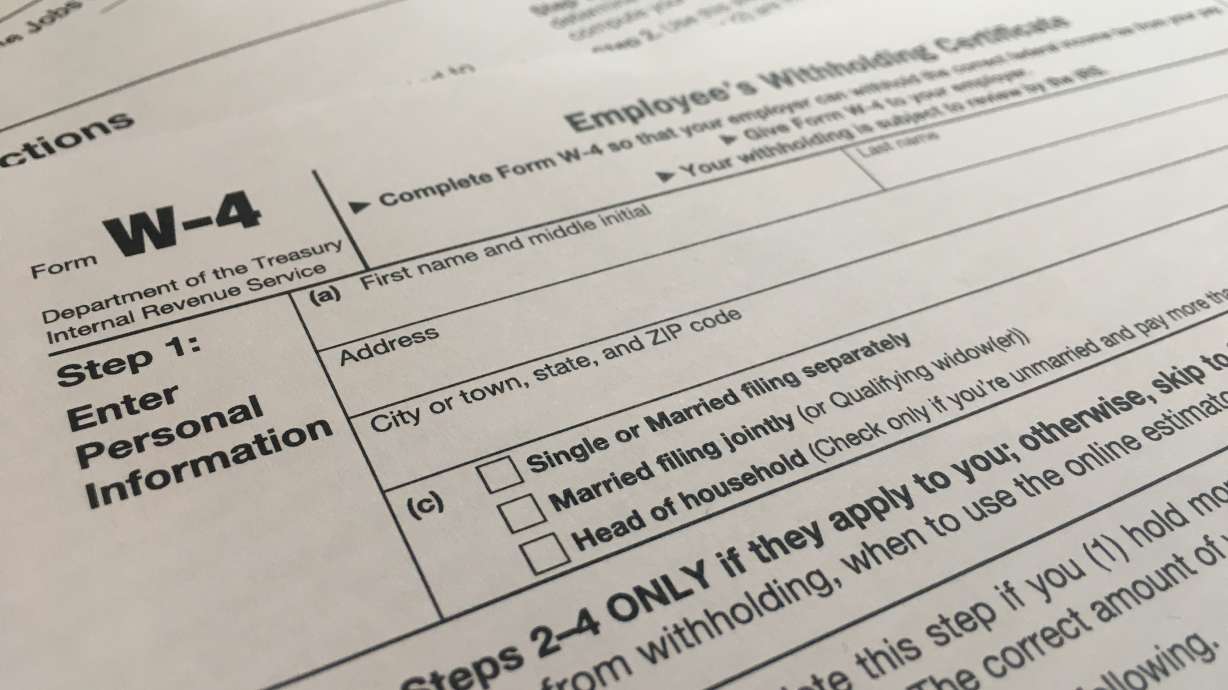Estimated read time: 5-6 minutes
This archived news story is available only for your personal, non-commercial use. Information in the story may be outdated or superseded by additional information. Reading or replaying the story in its archived form does not constitute a republication of the story.
If you are starting a new job this year, or just want to update your tax information with your employer, some of the paperwork is going to look different. A lot different.
The IRS has introduced a new Form W-4 that must be used by all employers in 2020 to better accommodate recent changes to the tax law.
The overhaul of the form is the biggest in decades and makes a once quick exercise a bit more involved. In return, according to the IRS, it will yield more accurate results. That is particularly important as the new tax law led to surprises for some folks last year, due in part to improper withholdings.
So the new form is worth a look, regardless of how long you have been on the job. The more accurate your W-4, the more accurate your withholdings are.
Withhold too little and you’ll owe money at tax time and possibly face a penalty. Withhold too much and you may be due a refund — which means you missed out on that money all year. Ideally you should break even.
Here’s what you should know:
WHAT’S DIFFERENT
Say goodbye to allowances, the backbone of the old W-4.
Employees used to answer a series of questions to arrive at a number of “allowances.” The allowances were based on personal exemptions — essentially how much income was exempt from tax based on how many people were dependent on the employee. But the new tax law did away with personal exemptions, so the IRS had to change its approach.
The form now collects information about all the income in an employee’s household, as well as dependents, to calculate how much to withhold.
THE DETAILS
The form is five steps long.
Steps 1 and 5 are mandatory — fill out your personal information and sign the form. For some people, that will be it. The other steps are optional but can help a taxpayer get more accurate results, says Alice Jacobsohn, senior manager of government relations for the American Payroll Association
Step 2 asks employees to provide information about all the income in their household if there are multiple jobs. This applies if the employee has more than one job or if both spouses work and file taxes jointly.
Employees can use an online calculator or worksheet to arrive at the correct amount, or they can simply check a box if the pay at both jobs is roughly equal. Payroll company ADP warns of a potential misstep here: if you have two jobs or are in a two-earner household and check this box — do so on the W-4s for both jobs. But only complete steps 3 and 4 on one W-4 to ensure the proper amount is withheld.
If an employee does not want to disclose that they have a second job or share their spouse’s income information, there are workarounds. The easiest is to use the IRS Tax Withholding Estimator at www.irs.gov/W4app to determine how much your household needs to withhold and enter that total lower on the form.
Step 3 is for claiming any dependents, which are generally consider those who are under age 17 and living with you more than half the year. You’ll need to complete an additional worksheet if you have other types of dependents to claim.
And Step 4 is where you can make any adjustments for other income, deductions or optional withholdings. This includes reporting other forms of income such as dividends or withdrawals from retirement accounts. There is also an option to enter a set amount of additional money to be withheld, including those who simply want to ensure they have a large refund.
“While the updated form may initially elicit some confusion for employees, these important changes will ultimately simplify the ability to set and adjust withholdings to achieve desired results,” said Pete Isberg, vice president for government affairs at ADP.
WHO NEEDS IT
Not everyone needs to fill out the new form.
In general, only new hires are asked to fill out a W-4. But anyone who wants to update their information with their employer will need to use it and experts say many of us should.
Ideally, people update their tax withholding information after major life events, such as marriage, divorce or the birth of a child. Additionally, anyone who was unhappy with their results at tax filing time last year should consider updating their paperwork.
A number of people were surprised to see a smaller refund, no refund, or to discover they owed money to the IRS at tax time. In part, this was because of inaccurate withholdings. After the law was passed, the IRS updated its withholding tables and urged taxpayers to update their W-4s as needed, but few did.
Employees who are happy with the amount of taxes withheld from their paycheck do not have to do anything.
WHERE TO GET HELP
If you are confused, check out the IRS website. It has a useful Q&A on the new form. The IRS Withholding Estimator is particularly helpful, walking employees through the process — something new and existing workers should consider.
Your human resources or payroll department can direct you toward helpful information but cannot provide advice. If you need additional help, consult a tax professional.
“Perhaps initially it is going to be difficult for people because it is a change,” said Jacobsohn. “But I suspect over time it will make it easier for people.”
Copyright © The Associated Press. All rights reserved. This material may not be published, broadcast, rewritten or redistributed.








